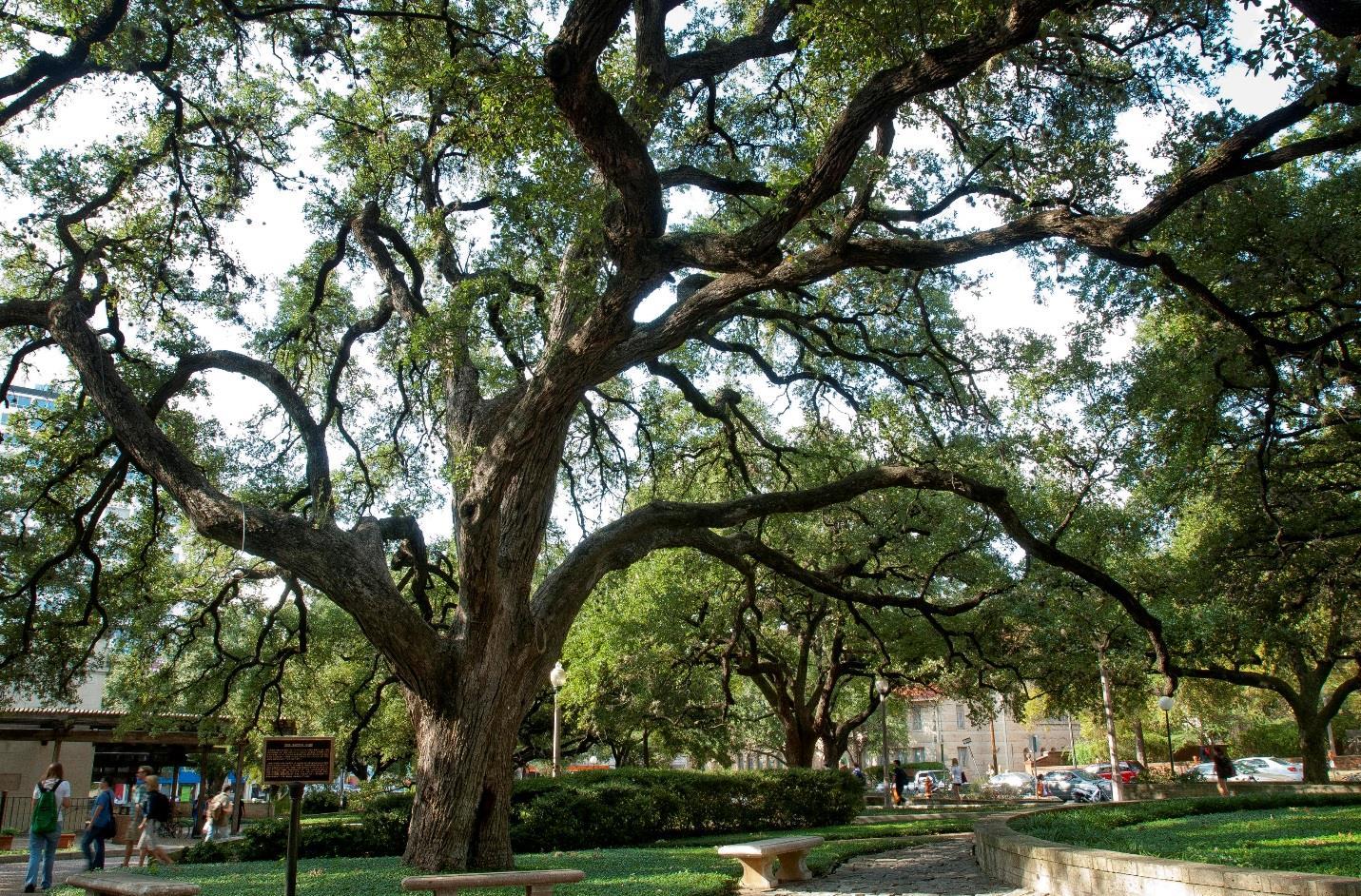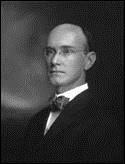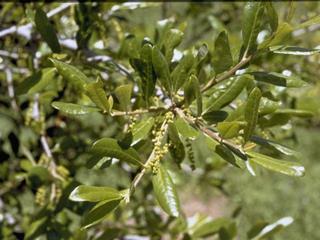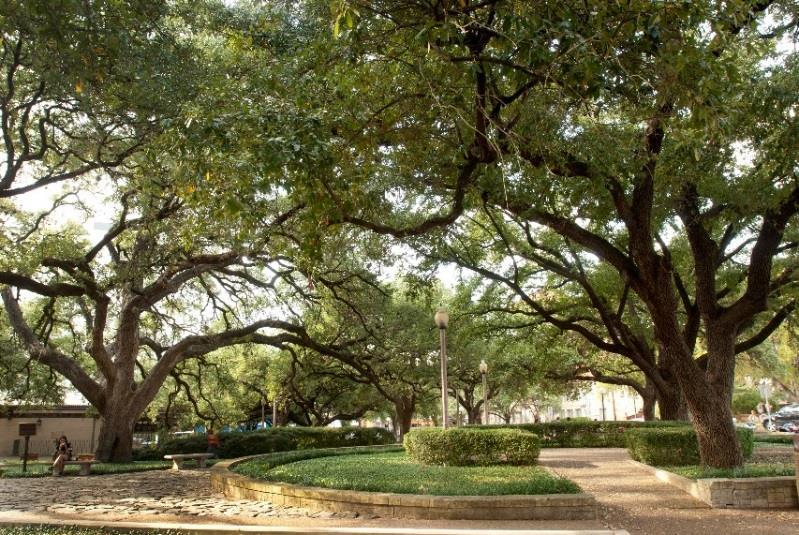Historical Significance
The Battle Oaks are among The University of Texas at Austin’s oldest living trees on campus at upwards of 250-300 years old. These three Texas live oaks graced the grounds of the original Forty Acres when the university opened in September 1883.

The Battle Oaks, photo by Marsha Miller
The largest of the trees is believed to predate the American Civil War (1861-1865), although it almost didn’t survive the devastation of the ensuing battle in 1863. As the story goes, General Magruder ordered his Confederate ranks to fortify Galveston. Legend says that when word was received that Northern troops had reached Galveston during the war, the hill of oaks was destroyed so that a fortress could be erected to protect the Capitol. All three trees survived the harvesting on the hill and were left where they still stand today.
Yet it is the story surrounding the fate of these majestic trees in 1923 that gave them the historic designation of the “Battle Oaks.” Dr. William James Battle was the university’s chairman of the Faculty Building Committee during this time. Construction of a new biological laboratories building was in the planning stages, and the site selected would have called for the trees to be destroyed. Concerned faculty and students appealed to Battle to save the trees. A group of professors even signed a petition. The conservation efforts worked. Battle became the trees’ greatest advocate as he convinced the Board of Regents to move the building site farther to the east in order to spare the trees.

Dr. James Battle
While a more colorful story emerged in later years, depicting a defiant Battle crouched under the oaks’ branches with a shotgun in hand, a different account from the archives of the Texas Exes’ Alcalde attributes the myth to another distinguished Longhorn. Robert Lynn Batts, former law professor, federal judge, and later Board of Regents member (Batts Hall was named in his honor) was away on business when he fired off a letter to Battle stating “he would ‘come down to Austin with a shotgun’ if that’s what was needed to save the oaks.” With or without their mythical past, the plaque adjacent to the trees and erected in honor of Dr. William James Battle defines them eloquently as “a source of enjoyment for many generations.”
Conservation
Conserving the university’s legendary trees goes beyond their historical significance for our Landscape Services team of experts, led by Urban Forester Jim Carse. After all, the trees are among the living plants and grounds that must be maintained year-round through all Texas weather conditions.
Our experts start with a working knowledge of each of the horticultural species present on campus and combine that with a collaborative relationship with another expert resource, The Lady Bird Johnson Wildflower Center. In the case of the Battle Oaks, they are classified as Quercas fusiformis, commonly referred to as the Texas live oak, escarpment live oak, or plateau oak. Typically found in dry climates, this species grows wild in its native soil of Texas and Oklahoma. Known among arborists as the hardiest of evergreen oaks, it is more drought-tolerant and able to withstand cold winters better than its close relatives. The tree’s “magnificent, stately form has endeared it to generations of residents,” states the Wildflower Center, “and it

Closeup of Quercas fusiformis, also known as Texas live oak Photo by Norman G. Flaigg
remains popular to this day.” Yet for all its strength and beauty, it is “susceptible to live oak wilt and live oak decline when stressed by drought.” So what is being done to preserve the Battle Oaks on campus?
As Carse explains, his team takes several precautionary steps:
Drought. Prolonged Texas heat takes its toll on most plants, but the trees are at a significant risk. Landscape Services had an irrigation system installed in the summer of 2011 in the Battle Oaks’ root zone to ensure the trees receive appropriate hydration.
Oak Wilt. While this fungal disease can cause plant discoloration, wilt, defoliation, and in some cases cause a tree to die, Carse states that “There are no known disease centers on campus, but we take precautions like painting all oak pruning cuts, sanitizing pruning tools, and monitoring for symptoms.”
Other Concerns. The team is watchful of other factors that affect the trees, such as soil health, soil compaction, proper pruning needs, and mulch application, and they take the necessary steps to maintain the trees properly.
Preservation
Good stewardship also includes preservation of the trees as an important asset of the campus community, contributing to the overall beauty and environmental landscape of the campus. Like Dr. Battle before them, this team of urban foresters takes their responsibility on behalf of the university very seriously. For example, careful documentation of the trees helps the team manage the large array of species present on campus. In fact, the tag numbers associated with these grand old oaks are 289, 292, and 293/294 (two tags are on one of the trees because its trunk is forked).
The team also works closely with the designers, architects and construction teams to erect safeguards for existing trees as new buildings are erected and help to identify which trees may be affected by future projects. The university’s 2014 Campus Landscape Master Plan talks quite a bit about the existing live oak canopy and the impact it has on the campus. The summary of the plan recommends reinforcing the street tree canopy and protecting the exceptional-sized trees on campus.

Asset tag from a campus tree
Another important component of preservation is education. “It’s our job to educate the UT community of the important role trees play on our campus and in all urban areas," explains Carse. Although he and his team realize that preserving all the trees all the time is not possible, they believe that helping others to learn why we need to conserve “this most critical resource in the landscape” will go a long way in building essential preservation support. After all, the Battle Oaks were once saved by determined and distinguished members of this very community who rallied around the call to prevent them from being destroyed. You could say that these trees stand today as a reminder of those noble efforts. As Carse affirms, “The trees are a great example of the respect that UT has for its natural resources, and they are a great story of the importance that trees hold in the lives of past and present students, staff and faculty at UT.”
Location
Where can you find these impressive trees on campus? A picture of them may be worth a thousand words, but nothing can replace seeing them with your own eyes. The Battle Oaks are located at the southwest corner of Whitis Avenue and 24th Street, near the Barbara Jordan statue. We encourage you to take a stroll across the Forty Acres to see these living legends. Perhaps, if you listen closely, you just might hear the faint sound of battle cries in the distance.

The Battle Oaks can be found at the corner of Whitis and 24th Photo by Marsha Miller
For more information about the Battle Oaks and urban forestry at The University of Texas at Austin, contact Jim Carse at jim.carse@austin.utexas.edu or at 512-475-7756.
